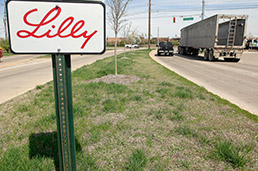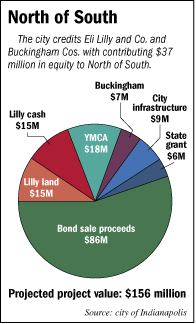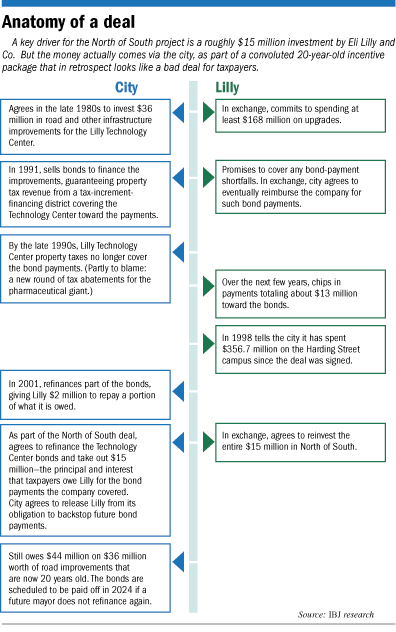Subscriber Benefit
As a subscriber you can listen to articles at work, in the car, or while you work out. Subscribe Now
 Proceeds from a refinancing of bonds that paid for road improvements near Lilly Technology Center will help fund North of South.(IBJ Photo/ Perry Reichanadter)
Proceeds from a refinancing of bonds that paid for road improvements near Lilly Technology Center will help fund North of South.(IBJ Photo/ Perry Reichanadter)The $156 million North of South project is a complicated, risky and potentially transformative bet on downtown.
It’s also a no-brainer of a deal, at least for Buckingham Cos., the developer, and Eli Lilly and Co., which owns the 15 acres of surface parking lots set to be developed along South Street east of Delaware Street.
That’s because taxpayers—acting as the project’s bankers—are shouldering most of the risk in the no-bid deal, while the potential for a tangible profit rests squarely in private hands, a review of documents and interviews with people familiar with the project show.
Buckingham stands to cash in every step of the way, earning fees for all three of its divisions—development, construction and property management. And Lilly gains a new amenity for its corporate campus while cashing out of a 20-year-old arrangement with the city that required the company to make periodic payments on infrastructure bonds.
 Taxpayers are putting up nearly every dollar used to build the apartment, hotel and retail project, chiefly by loaning $86 million raised from the sale of municipal bonds. All without the city’s landing any job commitments, charging the developer a spread above the city’s cost of capital as any banker would, or installing a mechanism for taxpayers to enjoy some upside if the deal succeeds.
Taxpayers are putting up nearly every dollar used to build the apartment, hotel and retail project, chiefly by loaning $86 million raised from the sale of municipal bonds. All without the city’s landing any job commitments, charging the developer a spread above the city’s cost of capital as any banker would, or installing a mechanism for taxpayers to enjoy some upside if the deal succeeds.
The benefits to the city are a larger tax base, a plugged hole in the downtown streetscape, and a powerful employment driver for the corporate campuses that surround the property, city officials say. They point to a study showing an estimated five-year economic impact for North of South of $350 million, and a conservative loan-to-value ratio of about 70 percent that gives taxpayers a good shot at recouping most of their investment.
Devil in the details
Several developers who spoke with IBJ on condition of anonymity and are generally supportive of public-private deals said the North of South arrangement upends the traditional risk-reward calculation for land development. They say any developer would have jumped at the deal the privately held Buckingham achieved.
“All the developer has is upside!” one said. “The taxpayer has all the risk.”
A 90-page project agreement provides insight into some of the risks. City officials declined to share the project agreement until they finalized the details and the City-County Council approved the plans in mid-March.
Buckingham, which has its headquarters at Ninth and Meridian streets downtown, broke ground on the project last month.
A few details found in the agreement and other documents:
• A $15 million cash contribution credited to Lilly is more complicated than it appears on the surface. Because Lilly’s Technology Center did not generate enough in property taxes to service the debt on a package of infrastructure improvements the city approved in the late 1980s, Lilly had to cover the shortfalls. Now, the city is paying back the pharmaceutical giant, and Lilly is reinvesting the proceeds in North of South.
The city also gives credit to Lilly for contributing the 15-acre site on which North of South will be built, valuing the property at $15 million. For tax purposes, though, the current assessed value of the 12 parcels set for development is $2 million.
• Buckingham is credited with a $7 million equity contribution. But that’s not money it put up. Rather, the sum represents the project’s development fees, which the company agreed to waive.
The company will be paid separately, out of municipal bond proceeds, for the project’s architecture and engineering costs and for construction management. Once North of South is complete, Buckingham will earn more cash by managing parts of the property.
If the project revenue is insufficient to make debt payments, Buckingham will be on the hook for the first $6.9 million, backed by a personal guarantee from Buckingham CEO Brad Chambers.
 • Buckingham could start cashing in profits from the project by selling individual components before taxpayers are paid back in full.
• Buckingham could start cashing in profits from the project by selling individual components before taxpayers are paid back in full.
The hotel, office and apartment phases each are assigned a “base release price” at which the bonds for that portion are considered satisfied. For instance, the release price for an office component starts at about $2.4 million (and falls as payments are made on the bonds).
If the developer can sell that portion, it can pocket any profit above the release price. A potential consequence of the arrangement is taxpayers could get stuck holding underperforming portions of the project while the developer cashes out of profitable ones.
Deron Kintner, executive director of the Indianapolis Bond Bank, said the city “increased the value” of various components to help guard against the risk.
“From Day One, when we started down this road, risk mitigation was of utmost importance to us,” he said.
• Taxpayers could be on the hook for building a multimillion-dollar parking structure for the adjacent WellPoint Inc. campus since the North of South project will remove some spaces and create more demand for existing ones.
The city is obligated to provide 2,000 free spaces to WellPoint as part of a 1997 agreement, expiring in 2012, that enticed the insurance giant to consolidate operations from the suburbs.
The North of South agreement suggests the city could pay Buckingham for use of some of the new spaces in the project or build a new garage at taxpayer expense. For reference, the North of South deal assigns a value of $12 million for its two parking garages and 800 total spaces.
Lilly is key
Lilly initially approached Buckingham in 2007 about putting together a redevelopment of the North of South properties.
The companies worked on the project for two years before approaching the city to request a $45 million subsidy to support it, Chambers said. City officials came back with an offer to act as a lender instead.
The decision came down to a philosophical question: Is it more prudent for the city to cap its exposure by investing a cash sum in a private development as it did with the JW Marriott and Conrad Indianapolis, or to put more money at risk for a chance to recover the full amount?
The city opted for the latter, giving Buckingham what amounts to a mortgage loan. Under the arrangement, after a two- to four-year period of construction and stabilization, the city will apply an estimated $2 million in property taxes and state income taxes on the North of South properties toward about $8 million in annual bond payments.
Buckingham will be responsible for paying the rest out of project revenue, Kintner said.
The city considered taking an equity stake but decided against clouding its role as lender, Kintner said. He said the city would have had to contribute more to the project to earn equity.
Chambers noted his company’s equity in the deal is merely theoretical until taxpayers are paid back.
“We’ve got significant motivation and skin in the game to work hard on this project, and have for three years now,” he said in an interview. “We’re going to work very hard to make this successful. At the end of the day, the project and its merits are solid.”
Chambers said a successful deal would be “very profitable” for Buckingham, but he would not provide a number.
Kintner said it doesn’t matter how much Buckingham profits on the deal as long as the city gets a new amenity and taxpayers are paid back. The project simply would not have worked if the developers had to tap private credit markets.
“Our goal was to protect the city’s interest and to see the project built and financed in a way that’s most advantageous to the city,” Kintner said. “Buckingham is no less at risk than other developers who have borrowed to put money in projects—they borrowed $97 million; there’s an inherent risk in that.”
Public and private?
The city sold about $98 million in bonds to finance the project and will kick in another $9 million for infrastructure improvements. Add in a $6 million state grant, and taxpayers are on the hook for about $113 million.
The bonds will generate $86 million for the project itself; the rest will cover fees and pre-paid interest for the time North of South is under construction.
City officials say the big public investment helped leverage $37 million in private contributions to the project by Lilly and Buckingham, though that figure includes the city’s payment to Lilly and the $7 million equity awarded to Buckingham in lieu of development fees.
The plans call for 320 apartments, a 157-room conference hotel, 40,000 square feet of retail or office space, and 800 parking spaces. An $18 million YMCA branch also is planned, but its financing is separate from the city-supported deal.
“These are amenities a lot of corporations move to the suburbs to chase,” said Scott Travis, Buckingham’s senior development executive.
But Melina Kennedy, the presumptive Democratic challenger to Republican Mayor Greg Ballard, was surprised the incentive package didn’t come with any job-creation commitments or an opportunity for taxpayers to earn some return alongside the developer if the project succeeds.
“Certainly, the actual development itself will be positive for downtown, but I believe some of the negotiating on the city’s behalf wasn’t as aggressive as it should have been to protect the taxpayers,” she said.
One protection the authors of the plan included was hiring locally based Keystone Construction Corp. as the city’s agent in the deal to watch over Buckingham. Regions Bank, meanwhile, is administering the loan on the city’s behalf.
“The city is acting as the bank on this project—taking on roughly the entire project in terms of risk financing,” Kennedy said. “If it fails, it will be on the city’s shoulders.”
The flip side is, if North of South succeeds, the city gains an asset that could attract more young professionals and make downtown more walkable, said former real estate broker and developer Gus Miller, who now works for a pension fund adviser.
He sees it as a prudent gamble to keep up the momentum that appeared in a recent study of U.S. Census data: Between 2000 and 2009, downtown Indianapolis saw an 83-percent rise in the number of college-educated residents ages 25 to 34.
And it helps when the risk involves a 27-year-old developer that manages more than 18,000 apartment units and has built 5,000 of its own. Buckingham also owns The Ambassador and Harness Factory Lofts apartment buildings downtown, and is developing The Avenue, a $25 million apartment and retail project along Indiana Avenue.
“We beat up people for pushing these kinds of things through,” Miller said of North of South. “You can build all kinds of sewers and roads, but at the end of the day, people like to live in communities. [The deal] is unorthodox, but we have to take risks to move forward as a community.”
Paying old debts
The North of South deal also settles a 20-year-old agreement between Lilly and the city that went expensively wrong for taxpayers.
City officials agreed in 1989 to vacate a portion of Kentucky Avenue and spend $36 million to widen surrounding roads to accommodate an expansion of the Lilly Technology Center.
The city sold bonds backed by property tax revenue on the property, but starting in 1997—thanks in part to a new round of abatements, Kintner said—the bond payments due exceeded the property tax payments, triggering an agreement for Lilly to cover the shortfall.
Lilly paid about $13 million toward the bond payments over the years, and would have been entitled to reimbursement from the city of the remaining balance after the original bonds were retired in 2020.
Instead, as part of North of South, the city opted to refinance the debt, paying off the remaining $15 million balance (including interest) owed to Lilly and forgiving the requirement that the company cover any shortfalls in bond payments. In exchange, Lilly agreed to reinvest the entire sum in North of South.
The upshot: Twenty years after building $36 million in road improvements, the city still owes $44 million. And it will continue making payments until 2024, unless a future mayor opts to refinance again.
Kintner doesn’t see a problem with taking 33 years to pay for road improvements since, he says, the point of municipal borrowing is to fund improvements with a long life.
In fact, Kintner said refinancing the bonds and paying Lilly now saves taxpayers $20 million. That’s because the city replaced bonds accruing interest at about 6 percent with new bonds at 3.5 percent.
Promises kept?
The 1989 agreement said Lilly was entitled to reimbursement only if it invested at least $168 million in improvements at its Technology Center along Harding Street. The company told the city in a March 1998 letter that its investments at the facility since Jan. 1, 1989, had totaled $357 million.
In 1999, the company announced a 10-year, $1 billion expansion in Indianapolis, a commitment Lilly spokesman Ed Sagebiel says the company also has met.
Yet during the North of South negotiations, Lilly was “doing cartwheels” to rid itself of its guarantee to cover bond payment shortfalls on the Harding Street project, Kintner said.
David Lewis, Lilly’s vice president of taxes, said the company hadn’t anticipated it would ever need to make the payments. He said “nothing comes to mind” on why the property taxes came up short of covering the bond payments.
“Assessed values used in the forecast and the ultimate values were different,” he said.
So did the city get enough in return for releasing Lilly from its obligation to backstop the bond payments?
“We negotiated with them for quite some time,” Kintner said. “Instead of a bonus to executives, they agreed to reinvest it into downtown.”
The payments between the city and Lilly seem murky to Christopher Steele, an economic development and site-selection consultant and president of Massachusetts-based CWS Consulting Group.
Steele applauds local governments that find creative ways to partner with developers after “sober reflection” to attain “broader public goals.”
But Steele, who reviewed the documents at IBJ’s request, described the agreements as “poorly negotiated.” He can’t quite understand how, if a company doesn’t pay enough property taxes to cover the bonds for its own infrastructure improvements, the city could wind up in arrears.
“There are very good and effective ways of structuring incentive and tax programs to build a strong and mutually reinforcing situation between company and community,” Steele said. “This is not one of them.”
He described the commitment that Lilly reinvest the proceeds in the North of South project as “trying to make a very bad deal better.”
Misplaced priorities?
Taxpayers are being fleeced, plain and simple, for a project that offers no clear benefit to the public, said Julia Vaughn, policy director for the government watchdog Common Cause Indiana.
If North of South really were such a certain success, the developers should have been willing to part with some of their own money to help finance it, she said.
“It really shows what the city’s priorities are,” Vaughn said. “We’re going to help out a private developer and one of the largest pharmaceutical companies in the world, yet we’ve got a second-rate public transport system, infrastructure is falling apart, neighborhoods have so many needs. But apparently the checkbook is open if you’re the right corporate citizen.”
The arrangement sounds like the deal between the city and the Indianapolis Colts that paved the way for Lucas Oil Stadium, said Gary Welsh, author of the cantankerous political blog Advance Indiana.
The city under former Mayor Bart Peterson credited the Colts with contributing about $100 million toward the stadium, but the claim was disingenuous at best: The team had simply agreed to waive the lease-termination fee on the RCA Dome in exchange for a state-of-the-art new stadium.
Welsh’s problem with deals like North of South is that they prevent property taxes collected downtown from going to anything other than new downtown projects, to the detriment of neighborhoods and schools.
“They always make those deals so complicated, deliberately so, to confuse people and make it seem like money is coming out of someone’s pocket that it really isn’t,” Welsh said.
But for Buckingham and Lilly, North of South makes perfect sense.
“It’s the deal of a lifetime,” said one local developer who would have bid on the project if given the opportunity. “I can’t imagine there would ever be anything like this again.”•
Please enable JavaScript to view this content.
